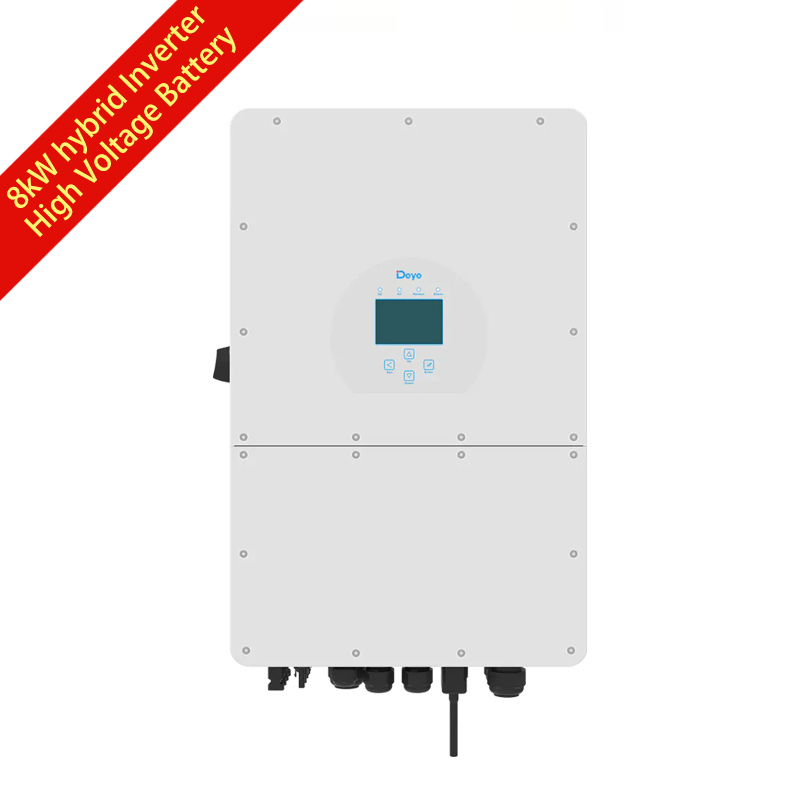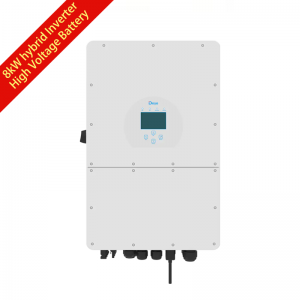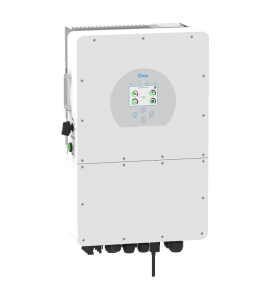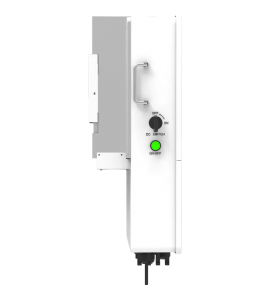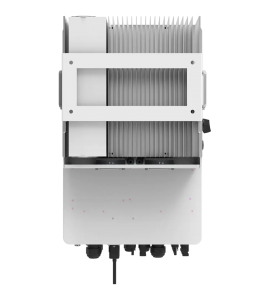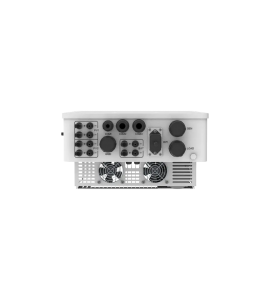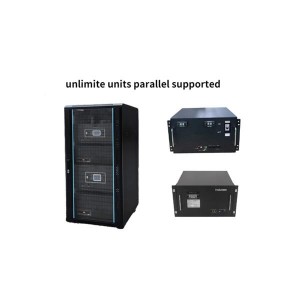

Deye 8kW Three Phase High Voltage Hybrid Solar Inverter
ABOUT
Deye 8kW Three Phase High Voltage Hybrid Solar Inverter
| Model | SUN-8K-SG01HP3-EU-AM2 |
| Battery Input Data | |
| Battery Type | Lithium-ion |
| Battery Voltage Range (V) | 160~700V |
| Max. Charging Current (A) | 37 |
| Max. Discharging Current (A) | 37 |
| Number of battery input | 1 |
| Charging Strategy for Li-Ion Battery | Self-adaption to BMS |
| PV String Input Data | |
| Max. DC Input Power (W) | 10400W |
| Max. DV Input Voltage (V) | 1000 |
| Start-up Voltage (V) | 180V |
| MPPT Range (V) | 150V-850V |
| Full Load DC Voltage Range (V) | 260-850 |
| Rated DC Input Voltage (V) | 600 |
| PV Input Current (A) | 20A+20A |
| Max. PV ISC (A) | 30A+30A |
| Number of MPPT / Strings per MPPT | 2/1 |
| AC Output Data | |
| Rated AC Output and UPS Power (W) | 8000W |
| Max. AC Output Power (W) | 8800W |
| Peak Power (off grid) | 1.5 times of rated power, 10 S |
| AC Output Rated Current (A) | 12.2/11.6 |
| Max. AC Current (A) | 18 |
| Max. Continuous AC Passthrough (A) | 40A |
| Output Frequency and Voltage | 50/60Hz;3L/N/PE 220/380Vac,230/400Vac |
| Grid Type | Three Phase |
| Current Harmonic Distortion | <0.5%1n |
| Efficiency | |
| Max. Efficiency | 97.60% |
| Euro Efficiency | 97.00% |
| MPPT Efficiency | 99.90% |
| Protection | |
| PV Input Lightning Protection | Integrated |
| Anti-islanding Protection | Integrated |
| PV String Input Reverse Polarity Protection | Integrated |
| Insulation Resistor Detection | Integrated |
| Residual Current Monitoring Unit | Integrated |
| Output Over Current Protection | Integrated |
| Output Shorted Protection | Integrated |
| Output Over Voltage Protection | DC Type II / AC Type Ⅲ |
| Surge protection | Integrated |
| Certifications and Standards | |
| Grid Regulation | VDE4105, IEC61727/62116, VDE0126, AS4777.2, CEI 0 21, EN50549-1, G98, G99, C10-11, UNE217002, NBR16149/NBR16150 |
| Safety EMC / Standard | IEC/EN 61000-6-1/2/3/4, IEC/EN 62109-1, IEC/EN 62109-2 |
| General Data | |
| Operating Temperature Range (℃) | -45~60℃, >45℃ Derating |
| Cooling | Smart cooling |
| Noise (dB) | <55 dB |
| Communication with BMS | RS485; CAN |
| Weight (kg) | 30.5 |
| Size (mm) | 408W×638H×237D |
| Protection Degree | IP65 |
| Installation Style | Wall-mounted |
| Warranty | 5 years |
Smart functions of solar inverters
Smart string monitoring in inverter
With the development of technology, the hybrid solar inverter has already realized intelligent string-by-string monitoring on the basis of the original MPPT monitoring. Compared with MPPT monitoring, group string monitoring monitors the voltage and current accurately to each branch string, and users can clearly view the real-time operation data of each group string. The number of component blocks in a string is inconsistent, which is clear at a glance.
Intelligent I-V curve scanning diagnosis of inverter
The I/V curve of photovoltaic modules refers to a corresponding relationship between the output current and output voltage of photovoltaic modules, which is expressed by researchers in the form of curves.
Once the components are shaded, damaged, or poorly connected, the I/V curves of the components and strings will change significantly.
The I/V curve of traditional test components requires special testing tools (I/V curve tester, irradiance meter and other equipment), and the strings to be tested need to be removed from the inverter and measured one by one. It takes a long time and delays power generation.
At present, mainstream high-performance hybrid solar inverters already have intelligent I-V curve scanning and diagnosis functions. The main implementation principles are as follows:
(1) Measure the string open circuit voltage Voc and short circuit current Isc.
(2) Measure the maximum power point voltage Vmpp and current Impp, and the peak power Pmax.
⑶ Identify photovoltaic module/array defects, shadow occlusion, dust loss of photovoltaic modules, temperature rise loss, power attenuation, series-parallel configuration loss, etc.
Intelligent recovery and grid connection of inverter
The reason why the hybrid solar inverter can realize automatic operation is because it has the function of intelligent recovery grid connection. The normal operation of the power station depends on many factors, such as string voltage, grid voltage, frequency, etc. The solar inverter may appear in standby or shutdown due to the lack of grid-connected output conditions. And once it detects that the operating conditions are normal, it will automatically restore the grid-connected output after self-test (generally 20s~5min), and there is no need for manual operations such as re-commissioning and restarting.
